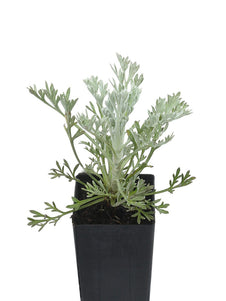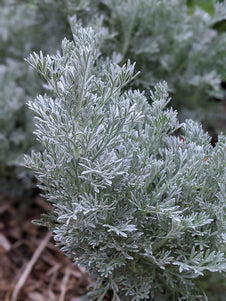



Wormwood Frigida
Wormwood Frigida

- Low stock - 12 items left
- Inventory on the way

Usually available: All year
Life cycle: Perennial
Height: 30 - 40cm
Position: Full sun
Soil preference: Well drained
This is how we pack and send your Herb Plants to all states except TAS & WA
You will receive
- 1 Wormwood ‘Frigida’ Herb Plant in a 50 X 75mm tube - General growing instructions
All of our Herb Plants are grown organically with certified organic potting mixes and fertilizers
Botanical Name: Artemisia frigida
Wormwood ‘Frigida’ is a small woody perennial growing to 30 - 40cm high and 50 wide. It has grey leaves with clusters of small, simple leaves held in alternate positions on the stem. The leaves are aromatic and after a downpour of rain the leaves have a distinctive aroma. The small leaves may be lobed and can look feathery from a distance. The yellow flower heads consist of a quite small individual flowers held in a round disk like cluster. The floral disks eventually release their seeds for wind dispersal. The root system is rhizomatous which helps propagation and survival.
The scientific name for Wormwood ‘Frigida’ is Artemisia frigida from the Asteraceae family. It may also be known as the Fringed Wormwood or Prairie Sagewort. It is found naturally growing in dry habitat on plains, rocky ground and prairies of Texas, Arizona and Northern Asia and Eurasia to elevations of 3000 meters. This is a Great Plains and Steppe plant which tolerates extremes of cold and heat, as well as dry conditions. There are many different Artemisia species which tend to grow well in dry, arid habitats. They have a long history of medicinal use and have been important to the folklore of many cultures.
For more information please see Common Wormwood and our other Wormwood plants for sale.
Growing Conditions
Wormwood Frigida grows best in full sun and will not tolerate shade well. It likes well drained soils of a light, sandy or loamy texture and can tolerate dry and drought like conditions very well once established. It does not like alkaline soils, but nutrient poor soil is tolerated. If water is available the plant will do well and can move between dry and moist conditions. In poor, dry soil a large taproot is grown to access scarce water sources. In times of good water supply the plant has surface roots available. Wormwood ‘Frigida’ may be propagated by seed, by taking cuttings in spring or by dividing the plants.
Culinary Uses
The Hopi Indians were said to use this Wormwood species to flavour items like sweet corn. Other Artemisia species have been used for different culinary purposes.
Medicinal Uses
All the Wormwoods have a history of traditional medicinal use for a number of health complaints. Wormwood Frigida is said to be of use for heartburn, coughs and colds, stomach complaints, regulating the menstrual cycle, to be a useful stimulant, and an antispasmodic. It can also be used as an insect repellent and the leaves are used as a treatment for intestinal worms. For toothache and nosebleeds a poultice can be made from the leaves. The roots are used to make a tonic or/and stimulant.
Other Uses
Wormwood Frigida is used as an insect repellent, a deodorant for pillows and to produce a green dye obtained from the leaves. The leaves were also burned to disinfect a room.
All information provided on this website is for informational purposes only. Please seek professional advice before commencing any treatment.






